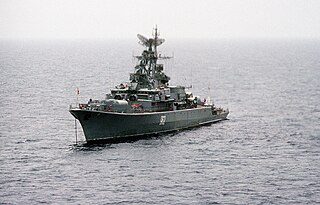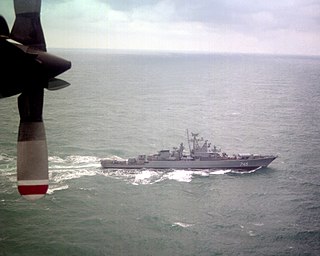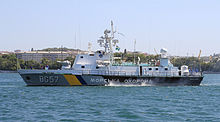
Razumnyy was a 1135 Burevestnik-class Large Anti-Submarine Ship or 'Krivak' class frigate that served with the Soviet and Russian Navies. Launched on 20 July 1973, the vessel operated as part of the Pacific Fleet, as a dedicated anti-submarine vessel, with an armament built around the Metel Anti-Ship Complex. The vessel undertook a number of tours, visiting the People's Democratic Republic of Yemen and India. The ship was decommissioned on 16 March 1998 and subsequently disarmed ready to be broken up before the end of the year.

Zadornyy was a Project 1135 Burevestnik-class guard ship or Krivak-class frigate that served with the Soviet and Russian Navies. Displacing 3,200 tonnes full load, the vessel was built around the Metel anti-submarine missile system. Zadornyy was launched on 25 March 1979 in Leningrad, the last of the class to be built by the A.A. Zhdanov shipyard, and served with the Northern Fleet. After taking part in exercises Avangard-81, Sever-81 and Okean-83, and cruising as far as Havana, Cuba, the vessel was upgraded between 11 June 1990 and 23 May 1995 with missiles that added anti-ship capability. While serving with the Russian Navy, the ship took part in joint exercises with frigates of the Royal Navy, including a commemoration of the first Arctic convoy of the Second World War with HMS Campbeltown. After more than twenty-five years service, the ship was decommissioned on 3 December 2005.

Doblestnyy was a Project 1135 Burevestnik-class Large Anti-Submarine Ship or Krivak-class frigate. With an armament centred on four Metel missiles, the ship was launched on 22 February 1973 and joined the Northern Fleet of the Soviet Navy as a dedicated anti-submarine vessel. Doblestnyy was designated a Guard Ship from 28 July 1977 in response to a change in emphasis of the navy, and subsequently undertook visits to a number of African nations, including Angola and Ghana. Taken out of service to be repaired and upgraded on 19 June 1991, a lack of funding meant that this was cancelled and instead the vessel was decommissioned. The vessel was sold to be broken up on 18 July 1995.

Svirepyy was a Project 1135 Burevestnik-class Large Anti-Submarine Ship or Krivak-class frigate that served with the Soviet Navy. Displacing 3,200 tonnes full load, the vessel was built around the Metel anti-submarine missile system. The ship was launched on 27 January 1971 in Kaliningrad and joined the Baltic Fleet. The ship's service was not restricted to the Baltic Sea and instead travelled widely, visiting a number of foreign friendly ports during the next two decades, including Gdynia, Poland and Havana, Cuba. Svirepyy was designated a Guard Ship from 1977 as Soviet strategy changed to one creating safe areas for friendly submarines close to the coast. However, the ship continued to travel widely, including trips to the capital cities of both Finland and Tunisia as well as Rostock in East Germany. Svirepyy was transferred to the Russian Navy after the dissolution of the Soviet Union, but did not last long before being decommissioned on 30 June 1993 and subsequently broken up.

Razyashchiy was a Project 1135 Burevestnik-class Large Anti-Submarine Ship or Krivak-class frigate of the Soviet Navy. Displacing 3,200 tonnes full load, the vessel was built around the Metel anti-submarine missile system. Launched on 22 July 1974, Razyashchiy joined the Pacific Fleet of the Soviet Navy. While serving in the Arabian Sea, in 1983, Razyashchiy suffered minor hull damage from colliding with the destroyer USS Fife while approaching a US fleet. The ship also undertook visits to Port Louis, Mauritius, and Danang, Vietnam, to, among other objectives, enhance the relationships between these countries and the Soviet Union. In 1991, the vessel was transferred to the newly-formed Russian Navy. After nearly twenty years of service, however, Razyashchiy was in a poor state and so was decommissioned on 29 October 1992 and sold to be broken up on 6 October 1994.

Grozyashchiy or Grozyashchy was a 1135M Burevestnik-class guard ship, or frigate with the NATO reporting name 'Krivak-II', that served with the Soviet and Russian Navies. Launched on 7 February 1977, the vessel operated as part of the Pacific Fleet as an anti-submarine vessel, with an armament built around the Metel Anti-Ship Complex. Grozyashchiy undertook a number of visits to nations friendly to the Soviet Union, including Angola, Mauritius, Mozambique and Sri Lanka. The ship also formed part of the Soviet presence during the Sino-Vietnamese conflicts and visited Da Nang, Vietnam, in the October 1981. With the dissolution of the Soviet Union, Grozyashchiy joined the Russian fleet, but lack of funding meant that a planned repair in 1992 was not completed and instead the vessel was decommissioned on 13 February 1995 and sold to be broken up.

Ryavnyy was a Project 1135M Burevestnik-class Guard Ship or 'Krivak II' class frigate that served with the Soviet Navy. Launched on 1 September 1979, the vessel operated as part of the Pacific Fleet as an anti-submarine vessel, with an armament built around the Metel Anti-Ship Complex. Ryavnyy took part in operations in the Indian and Pacific Oceans and undertook visits to countries friendly to the Soviet Union. The ship spent time in the Seychelles and North Yemen in 1982 and North Korea in 1985 and 1986. Taken out of service for an overhaul in 1989, Ryavnyy was instead placed in reserve until 17 July 1997, when the ship was decommissioned and sold to be broken up.

Gordelivy was a Project 1135M Burevestnik-class Guard Ship or 'Krivak II'-class frigate that served with the Soviet and Russian Navies. Launched on 3 May 1978, the vessel operated as part of the Pacific Fleet as an anti-submarine vessel, with an armament built around the Metel Anti-Ship Complex. Gordelivy operated in the Indian and Pacific Oceans. The ship was involved in the recovery of a BOR-4 prototype spaceplane in 1982 and undertook a friendly visit to Mumbia, India, in 1985. Decommissioned and sold to a South Korean company in 1994, Gordelivy left Russia on 27 June 1995 to be broken up.

Gromkiy was a Project 1135M Burevestnik-class Guard Ship or 'Krivak II'-class frigate that served with the Soviet and Russian Navies. Launched on 11 April 1978, the vessel operated as part of the Northern Fleet as an anti-submarine vessel, with an armament built around the URPK-5 Rastrub missile system. In 1991, the ship took part in the semicentennial commemoration of the first of the arctic convoys of the Second World War alongside the Royal Navy frigate HMS London. Soon afterwards, the ship was transferred to the Russian Navy following the dissolution of the Soviet Union. Gromkiy served for less than two years in this new role before being withdrawn for repairs and, ultimately, decommissioning on 16 March 1998.

Pytlivyy is a Project 1135M Burevestnik-class Guard Ship or 'Krivak II'-class frigate that served with the Soviet and Russian navies. Launched on 16 April 1981, the vessel was designed to operate as an anti-submarine vessel, with an armament built around the Metel Anti-Ship Complex. Part of the Black Sea Fleet, the vessel undertook friendly visits to Algeria, Greece, and Malta, at the last hosting a meeting between the Soviet and US leaders Mikhail Gorbachev and George H. W. Bush. In 1991, the ship was transferred to the Russian Navy following the dissolution of the Soviet Union, and, following a three-year repair, took part in a number of joint exercises with other navies. For example, 2003 found the vessel operating alongside the Indian Navy and 2005 with the Italian Navy. In 2006, Pytlivyy took part in NATO's Operation Active Endeavour and subsequently formed part of Russia's presence in the Mediterranean Sea in the war against terrorism in the early 21st century. The ship also operated as part of the Russian intervention in the Syrian civil war. As of 2021, Pytlivyy remains in service.

Rezvyy or Rezvy was the lead Project 1135M Burevestnik-class Guard Ship or 'Krivak II'-class frigate. Launched on 30 May 1975, the vessel was designed to operate in an anti-submarine role in the Soviet Navy, with armament built around the Metel Anti-Ship Complex. Part of the Northern Fleet, the vessel undertook operations in the Atlantic Ocean, including visits to Congo and Cuba, and participating in the Atlantic-84 major naval exercise in 1984. After a major refit between 1989 and 1992, Rezvyy was recommissioned into the Russian Navy. The ship continued to travel, visiting Norway in 1993. After more than twenty-five years service, Rezvyy was decommissioned on 1 June 2001 and subsequently broken up.

Silnyy or Silny was a Soviet Navy Project 1135 Burevestnik-class Large Anti-Submarine Ship or Krivak-class frigate. Displacing 3,200 tonnes full load, the vessel was built around the Metel anti-submarine missile system. Launched on 29 August 1972, Silnyy served with the Baltic Fleet. The vessel undertook a number of visits to nations friendly to the Soviet Union, including Cape Verde, Cuba, East Germany and Poland. In 1976, while escorting the aircraft carrier Kiev, the ship had a close encounter with the cruiser USS Josephus Daniels, although neither vessel was damaged. Silnyy was taken out of service for repairs in 1990. However, lack of funds meant that, instead, the ship was decommissioned on 30 June 1994 and broken up.

Neukrotimyy was a Project 1135M Burevestnik-class Guard Ship or 'Krivak II'-class frigate that served with the Soviet and Russian Navies. The vessel was known as Komsomolets Litvyy between 1987 and 1990. Launched on 17 September 1977, Neukrotimyy was designed to operate as an anti-submarine vessel with the Baltic Fleet, using an armament built around the Metel Anti-Ship Complex. The vessel undertook many visits to other countries outside the Soviet Unions, including Angola, East Germany, Nigeria and Poland. Following the dissolution of the Soviet Union, in 1991, the ship was transferred to the Russian Navy and continued to travel to countries like the Netherlands. Despite being accidentally holed in 2005 and being badly burnt in a fire in 2008, Neukrotimyy remained the penultimate of the class to remain in service, finally being decommissioned on 29 June 2009.
Chernihiv(U205) was a Grisha II-class anti-submarine corvette of the Ukrainian Navy. Prior to joining the Ukrainian Navy she was a former Soviet Navy corvette named Izmail.

Bessmennyy was a Project 1135M Burevestnik-class Guard Ship or 'Krivak II'-class frigate that served with the Soviet and Russian Navies. The vessel was the seventh of the class to enter service. Launched on 17 September 1977, Bessmennyy was designed to operate as an anti-submarine vessel with the Northern Fleet, using an armament built around the Metel Anti-Ship Complex. Following the dissolution of the Soviet Union, in 1991, the ship was transferred to the Russian Navy and took part in a pioneering visit to Gibraltar two years later, the first time that Russian warships had visited the territory in living memory. Bessmennyy was retired on 16 March 1998, disarmed and subsequently broken up.

Oryol is a Project 11351 Nerey-class frigate of the Coast Guard of the Border Service of the FSB of Russia. Previously the ship served in the KGB Border Troops Naval Service as Imeni XXVII siezda KPSS.

Menzhinskiy was the lead ship of Project 11351 Nerey-class frigate of the Soviet Border Troops and later the Coast Guard of the Federal Security Service of Russia.

Pskov was a Project 11351 Nerey-class frigate of the Coast Guard of the Federal Security Service of Russia. Previously the ship served in the KGB Border Troops Naval Service as Imeni 70-letiya VChK-KGB.

Anadyr was a Project 11351 Nerey-class frigate of the Coast Guard of the Federal Security Service of Russia. Previously the ship served in the KGB Border Troops Naval Service as Imeni 70-letiya Pogranvoysk.

Kedrov was a Project 11351 Nerey-class frigate of the Soviet Border Troops and later the Coast Guard of the Federal Security Service of Russia.



















